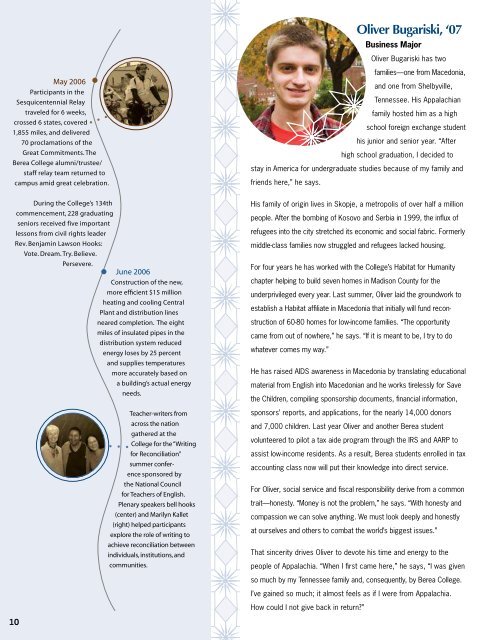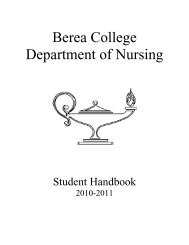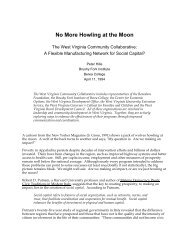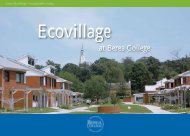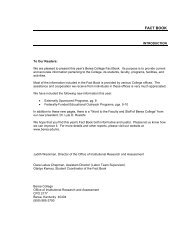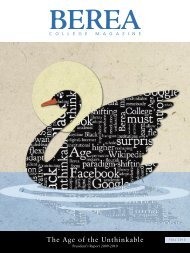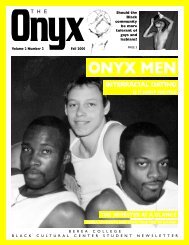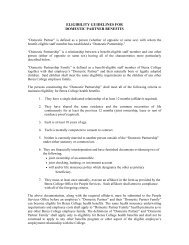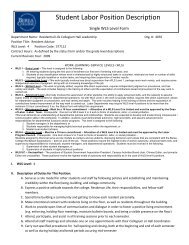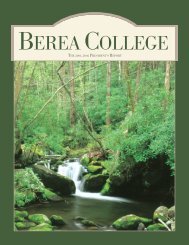What Makes for Peace? - Berea College
What Makes for Peace? - Berea College
What Makes for Peace? - Berea College
Create successful ePaper yourself
Turn your PDF publications into a flip-book with our unique Google optimized e-Paper software.
Oliver Bugariski, ‘07Jessica Fagan, ‘07The best known of all Afri-Business MajorChemistry & Biology Majorcan textiles, Kente comesOliver Bugariski has twoJessica Fagan, the daughterfrom the word kenten, orMay 2006Participants in theSesquicentennial Relayfamilies—one from Macedonia,and one from Shelbyville,Tennessee. His Appalachianof a horticulturist and aspeleologist, spent her childhoodin Blacksburg, Virginia,“basket.” Traditionally, thiscloth of kings was wovenfrom strips of cloth intotraveled <strong>for</strong> 6 weeks,crossed 6 states, covered1,855 miles, and delivered70 proclamations of theGreat Commitments. The<strong>Berea</strong> <strong>College</strong> alumni/trustee/staff relay team returned tocampus amid great celebration.During the <strong>College</strong>’s 134thcommencement, 228 graduatingseniors received five importantlessons from civil rights leaderRev. Benjamin Lawson Hooks:Vote. Dream. Try. Believe.Persevere.June 2006Construction of the new,more efficient $15 millionheating and cooling CentralPlant and distribution linesneared completion. The eightmiles of insulated pipes in thedistribution system reducedenergy loses by 25 percentand supplies temperaturesmore accurately based ona building’s actual energyneeds.Teacher-writers fromacross the nationgathered at the<strong>College</strong> <strong>for</strong> the “Writing<strong>for</strong> Reconciliation”summer conferencesponsored bythe National Council<strong>for</strong> Teachers of English.Plenary speakers bell hooks(center) and Marilyn Kallet(right) helped participantsexplore the role of writing toachieve reconciliation betweenindividuals, institutions, andcommunities.family hosted him as a highschool <strong>for</strong>eign exchange studenthis junior and senior year. “Afterhigh school graduation, I decided tostay in America <strong>for</strong> undergraduate studies because of my family andfriends here,” he says.His family of origin lives in Skopje, a metropolis of over half a millionpeople. After the bombing of Kosovo and Serbia in 1999, the influx ofrefugees into the city stretched its economic and social fabric. Formerlymiddle-class families now struggled and refugees lacked housing.For four years he has worked with the <strong>College</strong>’s Habitat <strong>for</strong> Humanitychapter helping to build seven homes in Madison County <strong>for</strong> theunderprivileged every year. Last summer, Oliver laid the groundwork toestablish a Habitat affiliate in Macedonia that initially will fund reconstructionof 60-80 homes <strong>for</strong> low-income families. “The opportunitycame from out of nowhere,” he says. “If it is meant to be, I try to dowhatever comes my way.”He has raised AIDS awareness in Macedonia by translating educationalmaterial from English into Macedonian and he works tirelessly <strong>for</strong> Savethe Children, compiling sponsorship documents, financial in<strong>for</strong>mation,sponsors’ reports, and applications, <strong>for</strong> the nearly 14,000 donorsand 7,000 children. Last year Oliver and another <strong>Berea</strong> studentvolunteered to pilot a tax aide program through the IRS and AARP toassist low-income residents. As a result, <strong>Berea</strong> students enrolled in taxaccounting class now will put their knowledge into direct service.For Oliver, social service and fiscal responsibility derive from a commontrait—honesty. “Money is not the problem,” he says. “With honesty andcompassion we can solve anything. We must look deeply and honestlyat ourselves and others to combat the world’s biggest issues.”That sincerity drives Oliver to devote his time and energy to thepeople of Appalachia. “When I first came here,” he says, “I was givenso much by my Tennessee family and, consequently, by <strong>Berea</strong> <strong>College</strong>.I’ve gained so much; it almost feels as if I were from Appalachia.exploring caves, hiking, andcamping. She carries thatpassion <strong>for</strong> the natural world withher—whether she is helping youngcampers discover frog habitats at a nature preserve, researching ina pharmaceutical laboratory, or tending the ecological machine andliving in <strong>Berea</strong>’s Ecovillage.In addition to science, Jessica has a passion <strong>for</strong> teaching, workingas an educational assistant in the science department at the<strong>Berea</strong> Community High School. “Many Appalachian schools lack theresources to prepare students <strong>for</strong> science careers,” she says. Asa student in a service-learning chemistry class taught by Dr. MarkCunningham, she took it upon herself to establish shared resourcesbetween the <strong>College</strong> and local high school, including taking studentsinto the <strong>College</strong>’s laboratory where they have access to more recenttechnology.As part of a national Morris K. Udall scholarship, she participated ina summer conference where she and others examined the humanseparation from nature. “Young students today are taught that theyare above the natural world,” says Jessica. “That sense of detachmentoften makes people rationalize inexcusable behavior toward theenvironment.”In Appalachia, Jessica sees poverty and health care issues asby-products of a degraded environment, saying, “Many of our socialproblems are related to the misuse of natural resources.” Relying onthe ingenuity of future generations to find solutions is not an option.She encourages action now. “If current issues aren’t addressed, theywill only become larger problems. Either we work together towardssustainability, or we will fight <strong>for</strong> the last drop of water.”At the close of the Udall conference she heard one participant say,“We will never again be together in the same room, but we will be inthe same world—living, working, learning, giving, growing, and yearningto make our lives better, more fulfilling, and more sustainable.”patterns rich in symbolism.Two motifs were usedFor thousands of years theolive branch has been used<strong>for</strong> this illustration: theas a sign of peace. It isdiamond pattern representssaid that cultivating olivesrespect; the other representsrequires such patiencethe black and white keys on thethat anyone whopiano. Only when both keys areplanted olive grovesplayed is a harmony possible.must be expectinga long and peacefullife. In the Bible, a dovereturned to Noah withan olive branch, signifyingthat the flood was over. TheThis star pattern looks dove often symbolizes peacereminiscent of a quilt and <strong>for</strong>giveness.design, but comesfrom a stained glasswindow inside the Domeof the Rock temple on theMount of Olives.This design incorporatesa mosaic pattern froman ancient dwellingand the star of theMacedonian flag, whichThe scientific diagram of a fractal abstractly representsincludes many linked circles the sun.that, when overlapped, <strong>for</strong>mthe universal “<strong>Peace</strong> ActionSymbol.” This symbol,designed in 1958,incorporates the flagsemaphore signal <strong>for</strong> theletters ‘N’ and ‘D’ that stand<strong>for</strong> Nuclear Disarmament.How could I not give back in return?”Yes, Jessica thinks, that’s an idea to hold onto.1011


